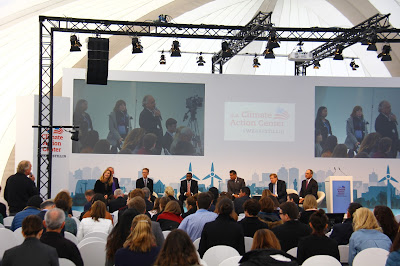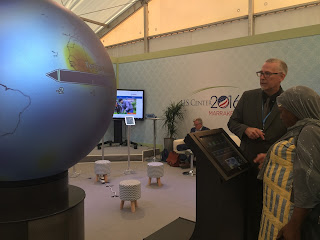A peek into the negotiations
 |
| Negotiations on Adaptation Finance at COP23 |
Assistant Professor
School of Marine Sciences and Climate Change Institute
A peek into the negotiations
There’s a whole lot that goes on at the UN climate negotiations, far more so than the one large negotiation hall of flags that one might imagine. I like to describe the annual UN Framework Convention on Climate Change Conference of the Parties – or COP – as a mix of Congressional committee hearings, an academic conference, and a music festival. The talks feature intensive lobbying and political grandstanding in numerous small rooms cloaked in esoteric policy technicalities. Nearby there are detailed and lengthy presentations in concurrent sessions featuring the latest analyses and insights from world-leading academic researchers, think-tanks, and NGOs. And it’s all surrounded by large art and music installations, celebrity media appearances and techno-chique country “pavilions” that feel like a 21st century sustainable technology version of a 19th century World’s Fair.
And so, as I embark on my fourth journey to a COP, and my first as a faculty member at the University of Maine, I want to paint for you a picture of what these negotiations are like – and how University of Maine faculty and students participate in this major global event.
Each year, the COP is run by a different country that takes the “presidency”. This year, that country is Fiji. The COP President runs the meeting and produces draft agreements on the basis of which the negotiations take place. The draft agreements are written based on instructions from the previous year’s meetings and the work plans developed under previous agreements. This year – two years after the Paris Agreement – the goals for the meeting are to continue to write the rules to implement the Paris Agreement, so Fiji is taking up the reins of what Morocco handed them from last year’s meeting in Marrakesh (See separate blog post – “What do we hope to accomplish at COP23?”).
Yet it would be impossible to negotiate so many details among nearly 200 countries in one huge room and reach consensus. To deal with this reality, the COP organizes work in three ways:
1. The negotiation is broken down into many separate meetings that work on different parts of the Agreement. For implementing the Paris Agreement, there is an agenda of eight separate items, each with sub-items. Each of these agenda items is tackled by a separate negotiating group with separate co-facilitators. In addition, there are other agenda item groups focused on other issues separately from implementing the Paris Agreement. This means that at any given point, you have to choose between about twelve different negotiations taking place simultaneously.
2. Countries usually negotiate in blocks. Even broken up into twelve smaller meetings, it would be impossible to hear from nearly 200 speakers in each room. Furthermore, some country delegations aren’t able to send someone to every single one of the simultaneous meetings (this is actually a major procedural justice issue which I’ll write about later this week). Because of this, countries have allied themselves into negotiating blocks which convene separately to coordinate their positions and then speak through a single spokesperson in the negotiation room. For example, there is an Arab Group, a Least Developed Countries Group, and a really big group called the G77+China (Group of 77 + China, which actually includes more than 100 developing countries at this point) and many others. In the meetings I have attended so far, the Bahamas spoke for G77+China, Malawi for the LDCs and Kuwait for the Arab Group. Other countries coordinate with each other during the course of the negotiation itself. For example, I saw negotiators from New Zealand, Australia and the United States (yes, the US is still here with negotiators negotiating!) huddling over computers and coordinating talking points together. In any given hour-long negotiation, only about 10-15 countries might actually speak.
3. There are lots of informal meetings. Finally, like any major political event, the “real” story takes place in closed backrooms where informal negotiations take place. It’s hard to know what goes on there, but easy to know it goes on.
A hot and crowded room with age-old divisions.
The conference rooms are crowded and the temperature control systems in the temporary conference facilities have been, somewhat ironically, poor, with rooms alternating between extremely warm and very cold, depending on whether the heat is on or off. The rooms feature tables where negotiators sit and chairs around the outside where observers and staffers for country delegations sit. Countries who want to speak during the negotiations take their country placard and place it in the “up” position (kind of like raising their hands) until they are recognized by the co-facilitator.
Country negotiators usually start their speeches with extensive thanks, and sometimes with bizarre metaphors or ironic jabs, garnering laughs. They also wax and wane between subtle technical details – think grammar fanatics (“this paragraph should refer to a particular agreement from three years ago only once, and not twice”), to impassioned pleas for action (“we must act now, my country is suffering, I implore you all to find the political will”).
Over the last two days I observed the agenda item under the negotiations focused on figuring out whether and how the Adaptation Fund (a $100s millions fund to help developing countries adapt to climate change created under the Kyoto Protocol) will continue under the Paris Agreement. I’ll share with you an illustration of how the negotiations work from those negotiations: One particular item in the draft text that vexed the negotiations for a while was the line that “innovative sources of finance” should be used to generate funds in the Adaptation Fund. Saudi Arabia asked for it to be deleted, saying they did not know what this word meant and they were concerned that it could mean robbing one pocket of developing countries to pay them in the other pocket through, for example, taxes on aviation or maritime emissions. Norway and Switzerland countered that there was long-standing agreement that multiple sources of financing were needed. The negotiations continued along these lines, with developing countries cautioning that they did not want “innovative finance” to be used as a way for developed countries to get out of providing finance. This divide, between global north and global south, has been part of the negotiations for the better part of two decades, and while lots of progress has been made in Paris in overcoming these divisions, it remains as a central structure throughout COP.
UMaine participation
So how do UMaine faculty and students participate? The University of Maine delegation have “Observer” passes, which gives us the right to observe many (but not all) of the negotiation proceedings. When the meetings are open, we are in the room with the negotiators and able to understand and see the climate policy sausage-making up close. This creates an opportunity for research on climate governance. Understanding how and why decisions are made the way that they are, and understanding the rhetoric and world-views of different countries and how those are created and reproduced are active areas of research. We are part of the RINGO (Research Non-Governmental Organization) group, which meets for daily briefings in the morning. Other RINGO schools include Vermont Law School, Colorado State, UC San Diego, Washington University at Saint Louis and a variety of small colleges.
But academic participation at COP is greater than observing meetings. Academic researchers also engage with country party negotiators in side events and provide information and background that is of interest to the negotiators through Q&A sessions. For example, ministers from Chile, Indonesia, Ecuador, Senegal, and other countries attended small side events I participated in yesterday. Furthermore, academic researchers are also asked to formally present their work and provide their expertise through side event panels.
Finally, as the largest gathering of climate policy experts in the world (there are around 25,000 people here), the annual COP presents a great opportunity to conduct qualitative social science research through key-informant interviews with negotiators and advocacy organizations to try to understand how the future of global climate policy is being constructed, and what the consequences will be for the planet and society.
Each member of the UMaine delegation is following different issues, attending different negotiation agenda items and participating in different side events.
Follow UMaine’s team on Twitter at #UMaineClimate and #CCIatCOP.



Great post Aaron, look forward to reading more.
ReplyDelete